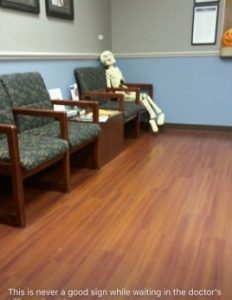Lean Healthcare Facilities 101
Did you know that hospitals and clinics can benefit from Lean principles, in much the same way as manufacturing plants? A Lean healthcare facility will have shorter or no wait times, less errors, and more time for the doctors to spend with each patient. In turn, they are more profitable and report better patient satisfaction. One of my best trainees is an engineer that works in hospitals, helping them achieve and maintain a Lean environment. But before we get into the how-to’s of bringing Lean into your hospital or medical facility, let me paint a couple of pictures for you.
Typical Current Doctor’s Office or E.R. Visit
Patients arrive and enter the waiting room. They check in, and wait in the waiting room until they’re called to have their vitals taken. After checking vitals, they go back to the waiting room. Afterwards, get their lab work done, before returning again to… the waiting room.

Are you starting to see an ugly pattern here?
Next, if they’re lucky, sometime within this decade they’ll be transferred to the exam room… where they sit and wait once again… for the doctor. Finally they have their brief visit with the doctor and are released to check out.
Medical community: We have to get over our obsessive infatuation with waiting rooms! I guarantee patients are more excited about receiving healthcare than being shuffled in and out of a waiting room.
[bctt tweet=”“Medical community: we have to get over our obsessive infatuation with waiting rooms! I guarantee our patients are not nearly as excited about them as we are!!!”” username=”@lightningsolve”]
What it Looks Like to Run a Lean Hospital
 First of all, you’ve completely taken out the waiting rooms. What a pleasant surprise! Now your patient will get checked in and immediately go in for their vitals and labs. After this, they are transferred to the exam room where the nurse or doctor meets them right away.
First of all, you’ve completely taken out the waiting rooms. What a pleasant surprise! Now your patient will get checked in and immediately go in for their vitals and labs. After this, they are transferred to the exam room where the nurse or doctor meets them right away.
Now they actually have more time to spend with their doctor. You’ve also used your fat trimming Lean Shears to cut out a lot of the useless nonsense formerly required of the doctors behind the scenes. The patient checks out. They were treated with excellence and never had to wait, so now they recommend your healthcare facility to everyone they know!
[bctt tweet=”“They were treated with excellence and never had to wait, so now they recommend your healthcare facility to everyone they know!”” username=”@lightningsolve”]
If this second scenario appeals to you, and you want your hospitals or healthcare facilities to become leaner machines, where do you start?
Bulldozer and Wrecking Ball Time!
Ok – you got me. I was teasing you about that! Clearly you can’t start by just removing your waiting rooms and watching chaos take place! Can you imagine?!! That would be a nightmare. But after a few logical steps and a little discipline, the lack of need for a waiting room can become a happy reality!
First off, you’ll need to start tracking value-added and non-value added events for every patient, nurse, doctor, and site. As soon as the patient gets to your clinic and checks in, the clock starts.
You time everything from the check-in time, to wait time in each room, to time spent on each test, time with a nurse, time spent waiting in the exam room for the doctor, etc. Based on this data, after a week or 2, you will easily see how your nurses are performing, how your doctors are performing, and how the entire site as a whole is performing.
Time is Money? Boy Are we Rich!
Now that you’ve recorded all those times, take your best nurse and best doctor and do a Value Stream Map and a Process Flow Diagram on them. The practices of your best performing nurse and your best performing doctor are now your targets. Drive the rest of the site to perform like the best doctor and nurse. Make this your standardized work or expectation.
[bctt tweet=”“Sorry doctors and nurses, you’ll all need to follow the standardized work.”” username=”@lightningsolve”]
Sometimes you might collectively decide which way you prefer, as long as you all do everything the same way and have the flow manager’s approval. But most things will be decided by the flow manager.
Hold up – What is a flow manager?
 Interesting that you should ask! A flow manager’s job is to track the flow of patients, making sure they’re steady and continuous. They should also routinely monitor every work station for optimal standards.
Interesting that you should ask! A flow manager’s job is to track the flow of patients, making sure they’re steady and continuous. They should also routinely monitor every work station for optimal standards.
Once your flow manager is in place, the next thing on your to-do list is Kaizen the top 10 reasons for visits. For example, if the most common visit is for back x-rays, then start with running Kaizen of the back x-ray visits. After the back x-rays, take your next largest reasons for visits, and Kaizen those. Continue through all 10 of your most commonly seen issues.
Also, every clinic should track its errors. Find the Root Cause of each incident – check out my video entitled “Root Cause vs Solution” for more in-depth troubleshooting. Put restraints in place to eliminate future incidents of the same kind. We call this process Irreversible Corrective Action. Drive your company so there’s a zero error policy.
[bctt tweet=”“Drive your company so there’s a zero error policy.”” username=”@lightningsolve”]
Finally, Waste Management Time!
These are all examples of waste:
- transportation
- inventory
- motion
- waiting time
- over-processing
- overproduction
- defects/errors
Look for ways to cut back waste from each of these categories and be sure to watch my video about Scrap Reduction for additional ideas.
Last Pitch for Flow Rider
I actually have found that it’s best to hire an expert from outside the medical field to assist with transforming the culture of your hospital or medical facility to embrace a Lean environment. A lot of times hospitals will look to hire a specialist with a background in nursing, thinking this is their best option. Unfortunately, it’s very hard to find someone that’s good at nursing and also an expert in Lean transformation. Nursing and Lean process management are very different skill sets! (Just ask Liam Neeson.) Hospitals are useless without nurses. But they are inefficient and wasteful without Lean Management.
[bctt tweet=”“Hospitals are useless without nurses. But they are inefficient and wasteful without Lean Management.”” username=”@lightningsolve”]
For example, if you have an expert landscaper to keep the botanical gardens perfect, why ask him/her to also maintain the state-of-the-art electronically controlled fountain system? Sure, it might be a great career move for your landscaper to learn the new system, but you really need to hire a fountain expert to maintain the fountain. It will save you time and money and attain perfection!
If you need help revolutionizing your hospital or healthcare facility with Lean practices, get in touch! And if this information has helped you at all, I’d love to hear about it in the comments below.
Thanks for stopping by, and have a great day!







